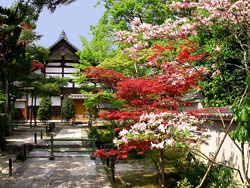Tenryu-ji is a Zen temple located on a slope of the Arashiyama district of Kyoto. It is ranked first among the city's "Five Great Zen Temples". Also called "heavenly dragon temple", the temple is listed on the UNESCO World Heritage list and is the head temple of the Tenryu-ji branch of Rinzai Zen Buddhism.

What to see
Like other Rinzai Zen temples in Kyoto such as Nanzen-ji, Tofuku-ji and Ryoan-ji, it is noted for its Zen gardens and extensive white buildings. The temple contains one of the oldest gardens in Kyoto.
The garden uses both the Arashiyama and Kameyama ranges as borrowed scenery to create a spectacular view in the Zen style pond circling garden. This expansive view is further enhanced by the large area of white sand that reaches from the Dai-hojo to the pond named Sogen-chi. This garden was originally designed as a Heian-style garden, but was later renovated to the Zen style. The main attraction is the dry waterfall that some think was true waterfall flowing into the pond. The flat, three-stone bridge you see in front of the waterfall is the first of this particular design and became very popular in Zen rock gardens.
Located within the Abbot's Chambers is a statue of the Buddha and and image of the Bodhisattva Nikko Hensho. The Taihoden or Main Hall is in the center of the temple grounds and contains a memorial tablet to the emperor Godaigo. To the right of the Taihoden is a Lecture Hall housing statues of Monju, Fugen, and Sakyamuni.
History
The temple was founded in 1339 by Shogun Ashikaga Takauji in memory of emperor Go-Daigo (1288-1339), with whom he sided during the civil war which brought to an end the Kamakura Shogunate (1185-1333). Ashikaga Takauji is the founder of the Ashikaga shogunate.
It may originally have been designed and constructed by priest Rankei Doryu (1213-78) at the request of Emperor Go-Saga. Tenryu-ji was actually a former villa of emperor Go-Daigo himself. The site had earlier been occupied by the Danrin-ji temple since the 9th century, the first Zen temple in Japan. Emperor Kameyama (1249-1305) built a villa on the propoerty, where his grandson Go-Daigo was raised and educated.
The Emperor Go-Saga (along with many of the nobility of the time) had used the area as a retreat, and Go-Saga had a residential palace here. Before Go-Saga, the site contained a garden, palace, a shrine dating to the Heian era (794-1185) that is believed to have been commissioned by Prince Kaneaki.
Ashikaga Takauji converted the former imperial residence into a Buddhist temple after having a vision/nightmare of a dragon rising from the nearby river and the temple was meant to placate the restless spirit of Emperor Go-Daigo - Takauji may also have had a guilty conscience as he had betrayed the Emperor and forced him into exile in Yoshino where he had died just before Takauji's vision.
A famous landscaper, Muso Soseki (1275-1351), also known as Kokushi, was placed in charge of opening the new Tenryu-ji Temple and garden. To raise money for the temple Takauji resumed trade with China. Today it is the base temple for the Rinzai-shu Sect of Zen Buddhism.
Tenryu-ji was ravaged by fires no less than eight times, last in 1864. It was destroyed during the Onin War. Reconstructed with the help of Toyotomi Hideyoshi the temple was yet again ravaged in the civil war at the end of the Edo period. Once again the temple was rebuilt and the buildings that grace the grounds today were constructed in the late 1880s.
Although the present building only date from 1900, the 14th century landscape garden is one of the oldest in Japan.
The current buildings date from the Meiji Period. Muso Soseki, the temple's founding abbot and famous garden designer, created Tenryu-ji's landscape garden which, unlike the temple buildings, survived the many fires and is considered one of the oldest of its kind.
Tenryu-ji has been designated a UNESCO world heritage site in 1995.
Address
68 Susukinobaba-cho Tenryuji Saga Ukyo-ku.
Tel: 075-881-1235 | Fax: 075-864-2424



